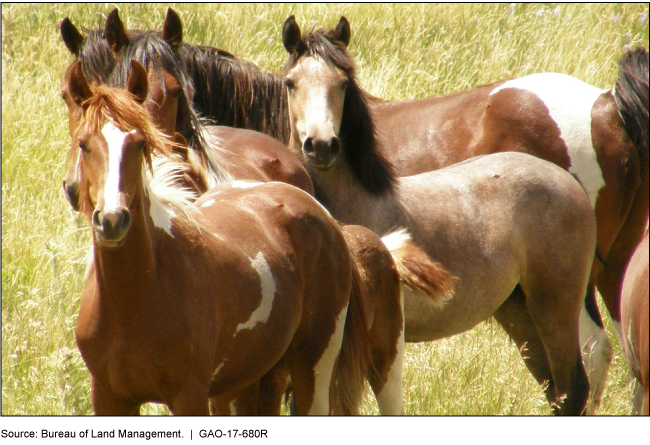Animal Welfare: Information on the U.S. Horse Population
Fast Facts
There could be as many as 9.2 million domesticated equines—including horses, burros, and mules—in the United States, and at least 200,000 free-roaming equines on federal and tribal lands.
Managing equine populations poses several challenges, including
Affording care for them
Finding new homes for unwanted equines
Protecting equine welfare, including when they are in transit for commercial slaughter
Controlling population growth
Addressing the potential environmental effects of free-roaming equines
We collected information on equine welfare to help federal and state agencies and nongovernmental stakeholders address some of these challenges.
Wild Horses on Public Lands

Photograph of wild horses standing in a field.
Highlights
What GAO Found
Federal agencies do not have a recent estimate of the total U.S. horse population. Available data suggest that the domesticated population may range from 5 million to 9 million, but there are limitations to these estimates. Data also suggest that the number of wild horses on public lands and in holding facilities has more than doubled in the past 16 years, to more than 110,000 in 2016, and that more than 90,000 feral horses reside on certain tribal lands.
Managing the horse population in the United States could include relocation to new homes, euthanasia or slaughter, or steps to prevent breeding. There are some differences in the options available for managing domesticated, wild, and feral horses. Specifically:
- The capacity to find new homes through rescue organizations and adoption is uncertain due to limited available information, according to stakeholders.
- Domesticated and feral horses may be exported to Mexico and Canada for commercial slaughter. The Bureau of Land Management (BLM) has placed conditions on sales and adoptions of wild horses to prevent their slaughter.
- Federal agencies and stakeholders have programs to control population growth. These efforts are not currently affordable or practical to implement on a large scale for reducing annual population growth and maintaining most wild horse populations at sustainable levels, according to BLM officials.
Stakeholders identified various types of impacts that free-roaming horse populations have on the environment, particularly in western states. These impacts may include harming native vegetation, altering the landscape, and dispersing seeds. Federal agencies support research to better understand these impacts.
Why GAO Did This Study
The U.S. horse population consists of domesticated horses in private care—such as race horses, show horses, and horses residing on farms—and free-roaming horses, including wild horses and burros on certain U.S. public lands and feral horses on tribal or other lands. The term 'horses’ refers to all equines, including burros, mules, and asses. Federal and state agencies and nongovernmental stakeholders have raised concerns about the availability of options for managing horse populations, such as challenges in finding homes for adoption and limited capacity at rescue sites; the cost of caring for wild horses; and the effectiveness of efforts to limit population growth and environmental impacts of free-roaming horses. Stakeholders have also raised concerns about the welfare of horses sold for export to either Mexico or Canada, which permit commercial slaughter of horses for human consumption. In the United States, such slaughter has been effectively prohibited by language Congress included in annual appropriations acts for fiscal years 2006 to 2011 and beginning again in fiscal year 2014. Specifically, the annual appropriations acts have prohibited the use of federal funds to inspect horses that are to be slaughtered for human consumption.
GAO was asked to review issues related to horse welfare. This report provides information on the (1) size of the U.S. horse population, (2) available options for managing the U.S. horse population, and (3) types of impacts, if any, that free-roaming horses have on the environment.
GAO reviewed and summarized agency, tribal, and nongovernmental stakeholder data and documentation related to horse population estimates and interviewed BLM, Bureau of Indian Affairs, U.S. Geological Survey, and U.S. Department of Agriculture officials; a state and a tribal government; and three nongovernmental stakeholders.
Recommendations
GAO is not making any recommendations in this report.
